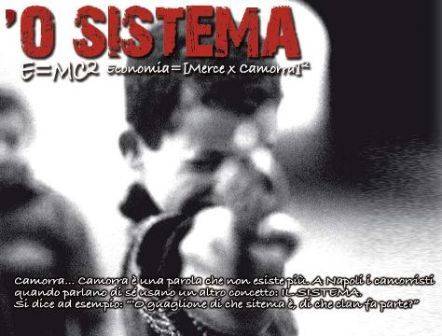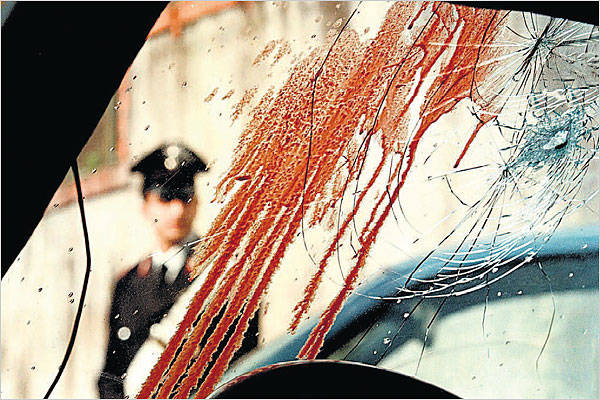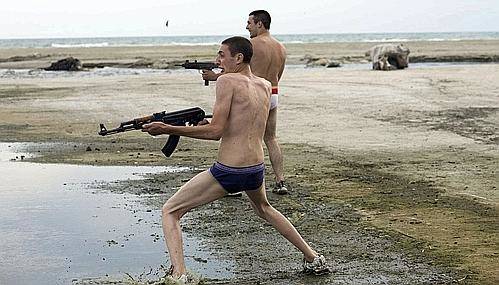"Gomorrah" by Matteo Garrone. A Modern Circle of Hell
Italian film director Paolo Sorrentino, in an interview with the British newspaper The Guardian, criticized Francis Coppola and Martin Scorsese for having “mythologized organized crime.” The two American auteurs “fell in love with mafiosi,” Sorrentino declared.
No one can say that about Matteo Garrone and his film Gomorra. Adapted from the acclaimed book of the same name by the courageous investigative journalist Roberto Saviano, Gomorra depicts Neapolitan organized crime as an all-enveloping and monstrous system of corruption and pitiless violence, a modern circle of Hell.
There are no larger than life Sicilian patriarchs in Gomorra, no “I make you laugh?” killer clowns, no Prozac-popping suburbanites. There are, in fact, none of the character types familiar from decades of Hollywood mob movies, and no psychology whatsoever. Garrone’s film, sociological in its emphasis and made in a quasi-documentary style that evokes neorealism, presents a devastating portrait of a city where organized crime gangs, known collectively as the camorra, operate with total impunity.
From its opening sequence of a massacre in a tanning salon to its final image of human lives literally reduced to garbage, Gomorra offers no solace or hope. No heroic reformers stand up to the mob, and the police always arrive too late, when the corpses already lie on the pavement oozing blood. Within this hellish universe there are decent and honorable individuals, but they are trapped by the system run by the violent and corrupt.
In the world of the camorristi, the cash nexus is everything; it determines and defines all human relationships. Family, friendship, faith, love – all are irrelevant to the making of money. The single-minded pursuit of profit makes lethal enemies of life-long friends, turns children into murderers, and contaminates the physical environment. The spirits of Marx and Brecht, not Coppola, Scorsese, or Chase, hover over Gomorra.
The film focuses on several of the camorra’s key profit centers – drugs, toxic waste disposal, and the fashion industry. These by no means constitute the entirety of camorra business. The clans also have their hands in tourism, arms dealing, the building trades, textiles, transport, food distribution, supermarkets, restaurants, banks, and cinemas. To depict all this activity, which is described in Saviano’s book, would have required a mini-series, like HBO’s recently departed The Wire. But highlighting drugs, toxic waste and fashion is sufficient to show the long reach of the camorra, how it operates on local, national, and international levels, from the squalid housing projects of Scampia to corporate offices in Venice to Milanese haute couture salons.
Five storylines, linked only by the fact that they all unfold within the camorra’s orbit, limn the terrain of this urban inferno. The characters are portrayed by a mix of established actors, including the fine Toni Servillo, star of Paolo Sorrentino’s un-romanticized 2005 Mafia movie The Consequences of Love, and non-professionals, with many of the latter recruited from working class neighborhoods dominated by the camorra.
Marco and Ciro, two gun-happy teenagers, think they’re living in Brian De Palma’s Scarface, as they quote lines of dialogue (“the world is ours!”) and act out scenes from the movie. Fearless but extremely foolhardy, they antagonize a local mob boss, first by stealing cocaine from his dealers and later by poaching a cache of high-tech weapons.
Totò, a quiet 13 year-old living in the Scampia projects, graduates from delivering groceries to a neighbor to delivering drugs. His involvement with the drug gang forces him to make a terrible and irrevocable choice that ensures his (temporary) survival and another’s death.
Don Ciro, middle-aged and nondescript, delivers cash to the families of imprisoned camorristi. The family members insult and berate him because the payments are never enough, but he remains impassive – until a war between rival clans shatters his composure and forces him to fight for his own survival.
Roberto, an unemployed thirty-year-old, gets a job working for Franco (Toni Servillo), a corporate camorrista who has gotten rich by dumping the toxic waste of Northern Italian firms in the once-pristine Campania countryside.
Pasquale is a talented tailor working for, or rather, exploited by, the mobbed-up owner of a black market sweatshop. A Chinese factory owner offers to pay him handsomely to teach his trade to the Chinese’s workers. For the first time in his working life Pasquale is well-compensated and treated respectfully – the Chinese call him “maestro” – but the camorra intervenes to put an end to his moonlighting.
Garrone’s multi-strand tale never descends to hokey contrivance or sentimentality, unlike Crash, the inexplicably acclaimed 2005 Paul Haggis film. In Gomorra the disparate characters live in the same world, but there are no epiphanies of mutual understanding, no affirmations of shared humanity. There is only the war of all against all.
Gomorra is set in Naples and its environs, but the film doesn’t condemn only that ancient and long-suffering city. By making explicit the symbiotic relationships between Campanian criminals and “legitimate” businesses in the north and center, Gomorra indicts not only Naples but Italy itself. How, one wonders, could a modern, purportedly democratic state and such a sophisticated civilization permit this to happen?
The film’s closing credits provide additional particulars for the indictment. Organized crime, which generates 150 billion euros per year, is Italy’s biggest business and a pillar of the European economy. In the past thirty years, the camorra has killed more people than any other organized crime group or terrorist organization. Scampia, on Naples’ periphery, is the world’s biggest open-air drug market. The carcinogenic toxic waste dumped by the camorra in southern Italy during the past three decades, if piled up, would reach a height almost twice that of Mount Everest.
Gomorra is a powerful and disturbing film that deserves the universal acclaim it has received. The Grand Prix winner at the 2008 Cannes Film Festival, it is Italy’s official entry for the 2009 Academy Awards. Gomorra also has been hailed as proof of the renewed vitality of Italian cinema. How ironic that a film that does Italy’s movie industry proud shames Italy as a nation.









































i-Italy
Facebook
Google+
This work may not be reproduced, in whole or in part, without prior written permission.
Questo lavoro non può essere riprodotto, in tutto o in parte, senza permesso scritto.